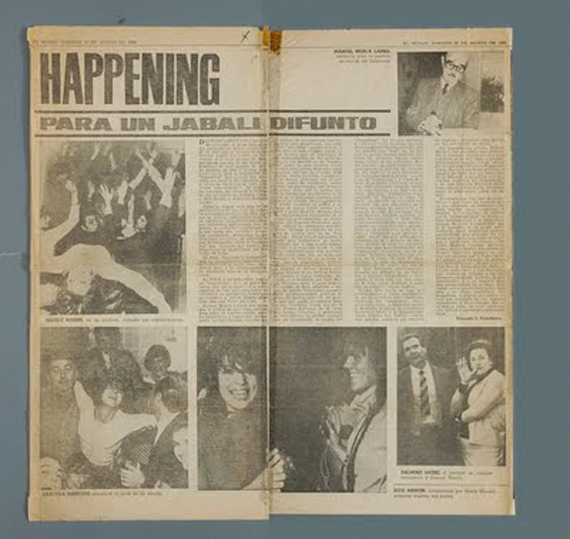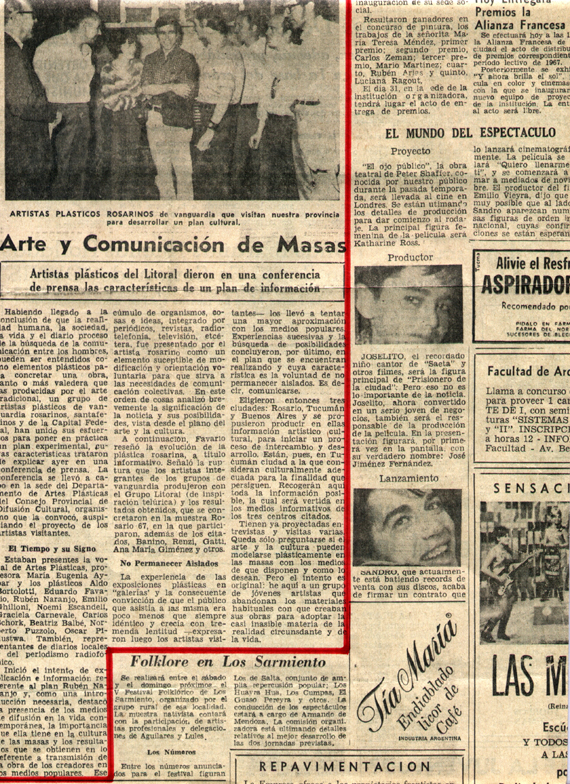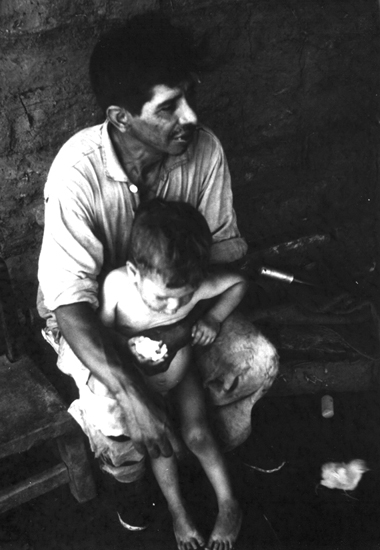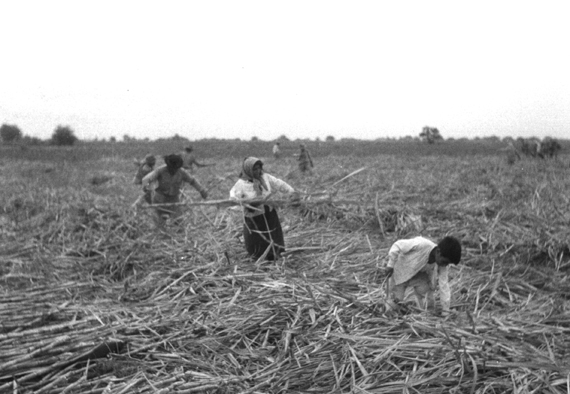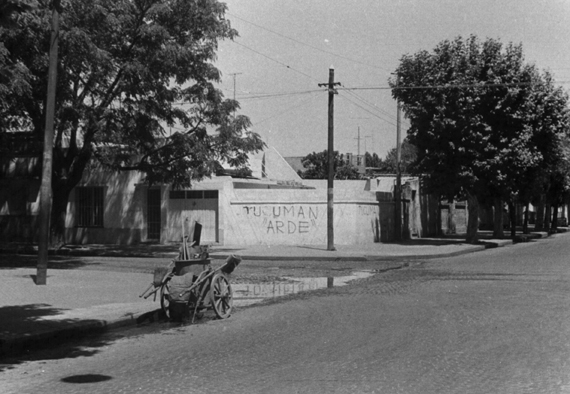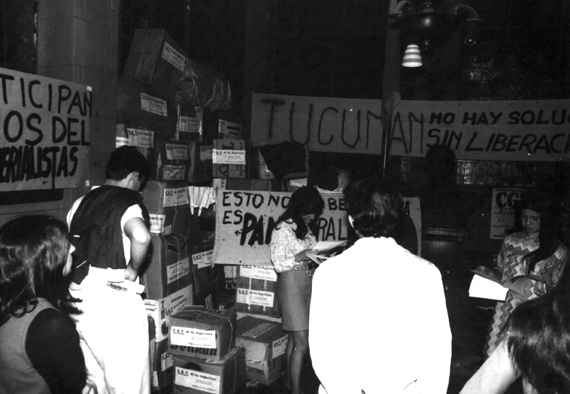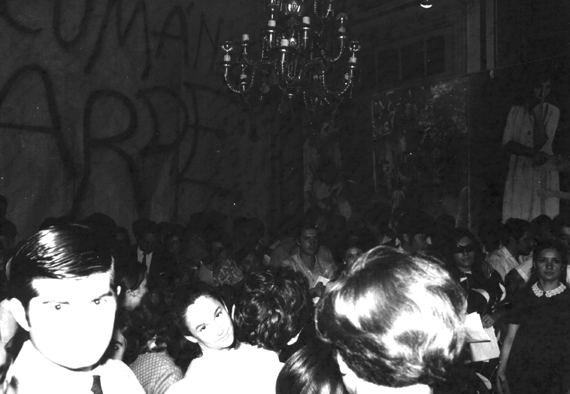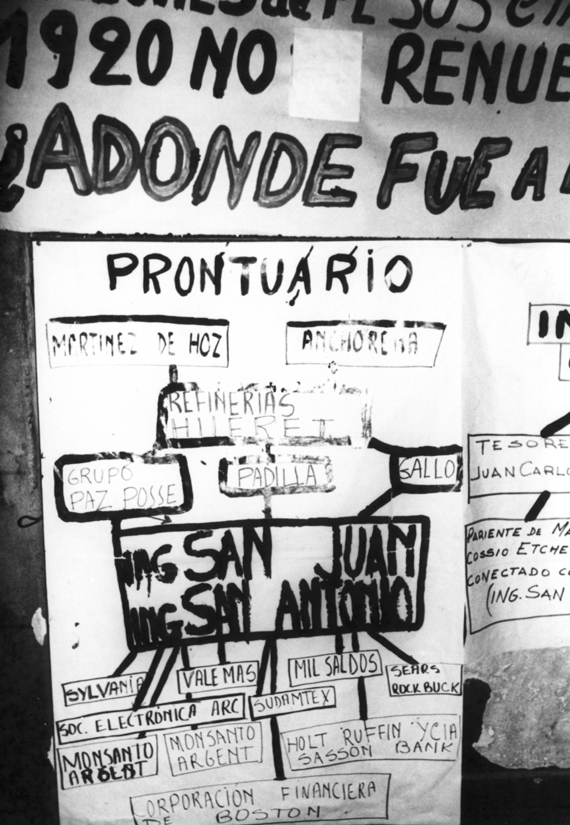08 2010
Tretyakov in Argentina
Factography and Operativity in the Artistic Avant-Garde and the Political Vanguard of the Sixties
Translated by Nuria Rodríguez
“Verum ipsum factum” (Giambattista Vico. Dell´antichisima sapienza italica, 1710)
“Factography” and “operativity” were two of the key concepts that articulated and galvanised Soviet Productivism. Their emergence brought about a change in the artistic praxis that affected both the structure of art works and their social function[1]. While factography envisaged the “writing of history” as the ultimate purpose of the politics of art, operativity predicted a new model of efficacy that aspired to overcoming the restrictions imposed by its mimetic regime (Fore 2006: 3-4). While not downplaying the historic and contextual differences,[2] the intentionally anachronic appropriation of the two concepts that this text deals with[3] is intended to shed further light on the meaning and continuum of the relationship between art and politics in the practice and discourse of the 1960s Argentinean avant-garde, emphasizing its asynchronic relation with other artistic practices of the same period under the aegis of “global conceptualism”.[4]
Some recent studies have contributed to a more detailed mapping of the history of Soviet Productivism, which still deserves to be recognised for its singularity within the Russian and “historic” avant-gardes.[5] These efforts have been joined by others which explore the manner in which the same practices were taken up by the neo-avantgarde in “advanced” countries (Río 2010).[6] In this regard, while the factographic drive is reflected in the output of different artists from both the Argentinean avant-garde and the international neo-avantgarde, the radicality of the productivist critique of the social function of art does not find in the latter the same extreme commitment that characterised the development of the relationship between art and politics in a large part of Argentinean art – not just its avant-garde – during the late sixties and early seventies.
A good point from which to embark on our interpretation is the theoretical and practical work of the critic Oscar Masotta, which is structured around concepts such as “discontinuity” and “dematerialisation.” The first of these was an attack on the organicity of the artwork, and had an enormous impact on artists such as Ricardo Carreira and Robert Plate, who took the deconstruction of the unity of the artwork to the verge of institutional critique. Their remission strategies sometimes adopted reflections derived from the Marxist tradition – such as the relationship between productive forces and commodities – and brought them into the field of art. For instance, in 1968 Plate held simultaneous exhibitions at two Buenos Aires galleries: in one he displayed a mould (Matriz, at Galería Vignes), and in the other the sheets that had issued from it (Producto, at Galería Lirolay).[7] Plate’s set-up, which radicalised the objectual dispersal of projects like Soga y texto (Ricardo Carreira, 1966), required visitors to engage in a process of deferred, mental reconstruction of the action-work, the traces of which were lost in the resulting products. The surplus value of the work was also supplemented by that which the art-market placed on the appearance of the object-commodity within its context.
Meanwhile, other theoretical developments around the concept of “dematerialisation” were taking place during the same period[8] In the case we are dealing with here, Masotta formulated the concept after reading El Lissitzky’s “The Future of the Book,” which had originally been published in 1927 and was reprinted in the New Left Review in early 1967.[9] Although the focus of the text was an analysis of potential contributions by avant-garde artists to the publishing industry from the point of view of typographic design, Masotta’s attention was drawn to the argument in which the Russian constructivist expounded upon the potentialities of a new alliance between art and technology:[10]
Consumers nowadays means everybody, the masses. The idea that moves the masses today is materialism; however, it is dematerialisation that defines our time. Take correspondence for instance: the number of letters, the amount of paper written on, grows; the mass of material consumed expands, until the advent of the telephone brings a measure of relief. Then the phenomenon is repeated all over again: the web of work and material supplied grows until the radio arrives to bring relief. The result: matter decreases; the process of dematerialisation is increasing all the time (El Lissitzky 2000: 43).
While contemporary movements such as Minimalism did turn their attention to Russian Constructivism (Foster 1996: 3-36), their re-reading fluctuated between somewhat ironic references to the fact that the apparent equating of artistic objects with industrially manufactured ones blurred their auratic singularity – which is partly what gives them their autonomy – and a revaluation of the physical relationship between the spectator and the artistic “object,” but it did not radically re-think the function of artists in relation to their social context. As for conceptual art, when Masotta recovered the concept of “dematerialisation” in his essay, it was not in order to bring about an alteration of the phenomenological experience of works – submerged in the invisibility of a Robert Barry – or their linguistic conversion into informative statements – which ideally subverted the logic of the market. Instead, it suggested the emancipatory power implicit in the mass receptivity offered by the expanding cultural industry. This may explain why, unlike Marta Minujín, David Lamelas and Oscar Bony, who largely carried out their experiments with media technologies within the avant-garde institutions, Masotta and the members of the group called “Arte de los Medios de Comunicación” – the artists Roberto Jacoby and Eduardo Costa and the journalist Raúl Escari, occasionally joined by Juan Risuelo – “constructed their works in actual mass communication circuits.” By making this shift, they glimpsed the possibility of “the reconnection between art and mass culture, its unprecedented expansion towards a mass recipient […] and even a potential political tool” (Longoni and Mestman 2007: 161). Their work with the media sought to generate gaps, defamiliarisations and interruptions in the normalised flow of information and images in the cultural industry of their time, in a manoeuvre that invited viewers to become conscious of the nature of the media that channel them.
Two complementary aspirations can be identified in their activities: on one hand, an urge to demythify the media; on the other, a desire to ultimately construct true “counter-information” circuits that would run parallel to and be independent from those they considered to be in imperialist hands.
The demythification of the media basically involved two strategies: an extreme self-referentiality that emphasised the intrinsic materiality of the medium; and an attempt to reveal the mythical nature of the media by means of the creation of a new myth. Examples of self-referentiality include interventions taken from institutional contexts, such as Oscar Masotta’s El mensaje fantasma and Roberto Jacoby’s Circuito automático. The tautological reciprocity of these works, both from 1966, subverted the communicative logic of the mechanisms that they infiltrated; their absolute denial of all exteriority was not the result of an unquestioned and dogmatic essentiality of the medium, but instead tried to reveal its subservience to an instrumental rationality.
Meanwhile, the strategy of demythification by means of the creation of a new myth was summed up in a Roland Barthes quote that Jacoby included in the manifesto “Contra el happening,” (“Against the Happening”) which he wrote in 1967. The fragment, taken from the article “Le Mythe aujourd´hui” (included in the book Mythologies, 1957), went as follows: “Truth to tell, the best weapon against myth is perhaps to mythify it in its turn, and to produce an artificial myth (...) It is what could be called an experimental myth, a second-order myth” (Jacoby 2004: 238). Jacoby was the driving force behind the Happening para un jabalí difunto (1966), a project that materialised Barthes’s proposed politicisation of myth. The “anti-happening” consisted of using the mass media to spread written information and images about an event (the supposed happening) that never took place. The initiative, carried out with the complicity of several journalists, marked the emergence of a new artistic modality – art of the media[11] –, which recognised and accepted the consequences of the rapid neutralization of happenings, absorbed as a new fad by institutions and the media (Longoni 2004: 69). By focusing on the media – which were the protagonists of this process – the artists brought into play a reflection that exceeded the bounds of the history of the institutional avant-garde. This exercise in simulation did not seek to reveal the falseness of information spread by the media, but, by carrying out an equivalent operation, it drew attention to the fact that the media manufacture events (Longoni 2004: 72-73).[12] The idea was not just to “demonstrate that the press deceives or distorts,” a notion that was considered “obvious and a matter of common sense,” but to set up a “play between the reality of things and the unreality of information, between the reality of information and the unreality of things, with the materialisation, through mass art of the media, of imaginary facts, of one imaginary constructed on the basis of another” (Jacoby 2004: 167 ). The factual materiality of the new vehicle for expression ran counter to the literary materiality of traditional artistic genres, and this generated a space of epistemological uncertainty that threatened to destroy the boundary between truth and fiction, realism and constructivism:[13]
The account of something that had never taken place (and was therefore false, fictitious) was not a simple literary fiction – as it would have been had it been included in a collection of stories – but the communicational context endowed it with a factual rather than literary materiality (Jacoby 2004: 229).
Art of the media, “Happeining para un jabalí difunto” (“Happening for a Dead Wild Boar”), 1966
The project was thus related to the “dialectical overcoming” of the antithetical relationship between literary quality and political commitment, form and content, suggested by Walter Benjamin in “The Author as Producer”.[14] Benjamin believed that the blurring of traditional genres of art and literature in favour of a factual materiality brought the artist closer to the emergence of a new “literary” form – the newspaper –, which would pass over those oppositions and do away with the distinction between author and reader.[15] To support his thesis, the German author used the example of Sergei Tretyakov, a Russian productivist writer, who carried out his work at the Communist Lighthouse kolkhozy (collective farm) in the second half of the 1920s,[16] where he organised initiatives such as a newspaper made by the peasants, whose amateur production went against the elitist nature of bourgeois artistic and literary practice.[17]
In the Argentinean avant-garde of the sixties, Benjamin’s ideas around the operativity of the artist-producer were filtered through the aforementioned text by Roland Barthes. In the writings of the French semiologist, the revolution generated a discursive space that was located outside of the sphere of myth. The language of revolution corresponded with that of “man as producer”:
Il y a donc un langage qui n´est pas mythique, c´est le langage de l´homme producteur: partout où l´homme parle pour transformer le réel et non plus le conserver en image, partout où il lie son langage à la fabrication des choses, [...] le mythe est impossible. Voilà pourquoi le langage proprement révolutionnaire ne peut être una langage mythique. La révolution se définit comme un acte cathartique destiné à révéler la charge politique du monde: elle fait le monde, et son langage, tout son langage, est absorbé fonctionnellement dans ce faire (Barthes 1957: 234)[18].
“Le Mythe aujourd´hui” was thus to be a true paratext for the course taken by the Argentinean avant-garde during the sixties. While art of the media had revealed the mythic nature of information by means of the construction of a second-order myth, the protagonists of the “itinerario del 68[19]” occupied the gap between the artistic avant-garde and the political vanguard, marked by a revolutionary impulse that aimed to challenge the persistence of representation in the field of critical art.[20] In its performative dimension, their self-proclaimed avant-gardism connected language with that need to “make” that led the artists involved to revive the operative model implemented by Tretyakov in the twenties, and later summoned by Bertolt Brecht. As described by Georges Didi-Huberman, “Tretyakov talked about ‘revolutionary literature’ in cinematic and counter-informational terms as ‘new reportages,’ poets were to position themselves ‘closer to newspapers’ than ever before (2008: 20 –the emphasis is mine).
That very concept of “counterinformation” was to be one of the recurring arguments in the journalistic practices of Tucumán Arde (Longoni and Mestman 2008). Embodying the collective ideology of the debates of the post-revolutionary Russian avant-garde (Zalambani 1998: 62-65), the artists redefined the critical nature of “art of the media,” in order to generate marginal spaces and parallel circuits of information, an aim that entailed a change in the procedures and contexts of artistic production and reception. Curiously, in Tucumán Arde, the expression of the key ideas of “art of the media” functioned as a kind of letter of introduction to the press, a manoeuvre to draw attention away from the ultimate aims of the project. It is as though the artists had realised that “art of the media” was starting to succumb to the same neutralising fate that had earlier been detected in the happenings at Di Tella. Thus, at a press conference organised during one of the field trips to Tucumán province in the lead up to the exhibition in Rosario, some of the people working on the project explained that the plan was to create a work that revolved around the relationship between “art and mass communication.” True to the concept of factual materiality that we discussed earlier, the artists stated that they would use “concrete reality as material for artistic creation through the media.”[21] But the place where they actually planned to present the material they had been compiling in relation to the Tucumán sugar crisis was the headquarters of the CGT (Confederación General de los Trabajadores) trade union in Rosario, aligned with the branch that was not in power in the split CGT de los Argentinos. They accepted that for as long as the means of cultural production remained in the hands of the landowning classes, they must necessarily create intersubjective spaces that would implement “a grassroots information and communications network”[22].
La Gaceta, October 23, 1968. Page from a Tucumán newspaper reporting on the artists’ supposed intention to create a work that would connect art and the mass media. Graciela Carnevale Archive.
The Tucumán Arde exhibition layout emphasised the use of photography and information, in a synthesis of two specific aesthetic ideologies: on one hand, the use of images as evidence of poverty; on the other, the visitor’s immersion into an environment packed with visual and textual stimuli. In terms of the first, the use of photography spread its roots in what Jorge Ribalta has called the “[photographic] tradition of the victim” (Ribalta 2008: 12-21). The founding milestone of this iconography goes back to the idea of documentary photography expressed by John Grierson in 1926, and the first actual productions in the campaigns promoted by reformist policies in the United States in the early decades of the twentieth century, which culminated in the second half of the thirties with the Farm Security Administration (FSA) project. In Tucumán Arde, this vision, which Martha Rosler would link to the “social conscience of liberal sensibility presented in visual imagery” (Rosler 2004: 303), would subordinate its strictly informative aspect to the empathetic and compassionate activation of the viewer in a context marked by the emergence of the New Left in Argentina, in which certain sectors of Peronism proposed a synthesis between Christianity and Marxism. Martha Rosler herself pointed out the connections between the emergence of documentary photography and “Christian ethics” (Rosler 2004: 72). The notion of charity, which is central to this ethic, hovered over some of the initiatives that took place within the Argentinean project, such as the stand set up to collect food to be sent to Tucumán province. As a counterpoint, the stand displayed a text noting that its promoters did not intend it to be a charitable work, but to wished ameliorate social justice.
Two of the photographs taken by the artists involved in Tucumán Arde during a trip to the Tucumán sugar refineries, showing some of the hardship suffered by the workers, 1968, Graciela Carnevale Archive.
Nevertheless, it is impossible to establish a theory of the reception of these images by looking at them in isolation, because each individual image ultimately played a secondary role in which its predominant “metonymic adaptation” served as proof of its veracity[23]. When it came to formalizing their approach to the problems in Tucumán province, the artists were not principally interested in objectively reproducing reality (as proposed by Grierson) through an organised compilation of documents. Instead, they wanted to generate an environmental dispositif that would spread the spectre of the revolution among those present. To this end, the final exhibition layout at the CGT headquarters subordinated the documentary and textual aspects of the material they had compiled to the overarching concept of “overinformation,” another of the key concepts in the literature of the “itinerario del 68.” This excess of information was expressed through the ambient saturation created by the multitude of sensorial and, in particular, informational stimuli at the exhibition, which sought to trigger visitors’ political awareness and at the same time mobilise them politically in a specific direction. Although it is possible to trace a genealogy of these strategies that would lead back to El Lissitzky’s propaganda exhibitions in the second half of the twenties (Aynsley 2008: 83-107 and Pohlmann 2008: 167-191), the “occupation” of the trade union building with photographs, statistics, oral testimonies, fragments of newspapers, texts, film screenings, and so on, went beyond the mise-en-scènes of the Russian constructivist. Refusing to limit itself to a more or less confined space, the factographic (literally, “writing of facts”) presentation of the material compiled revealed the level of radicality that the Argentinean avant-garde had achieved in the sixties. As Ana Longoni and Mariano Mestman point out, “rather than being understood as a traditional art show held at a trade union, the Tucumán Arde exhibitions could be seen as bringing into play a mode in which art moves into/appropriates/merges with an alternative public space outside of art circuits” (Longoni and Mestman 2008: 201). In comparison with El Lissitzky’s “photo-frescoes,” – including the eloquently titled The Task of the Press is the Education of the Masses, which the Russian constructivist designed for the Soviet pavilion at the Internationale Presse-Ausstellung exhibition held in Cologne between May and October 1928, and which included visual, textual and statistical material (Buchloh 2004: 84) – what made Tucumán Arde different was not just the desire to connect with an alternative audience – through the shift from the context of an international exhibition to that of a trade union – and the collective nature of the process of production-formalisation, but also the insistence in rejecting the “exhibition” format as a recognisable feature of (bourgeois) art by means of overflowing the normalised format and traditional venues for the presentation of documents.
Tucumán Arde: images of the public campaign in Rosario and the exhibition at the CGT headquarters, 1968, Graciela Carnevale Archive.
While it is true that Tucumán Arde invented new forms of visibility that have subsequently been taken up and developed by critical art – the cartographies that revealed the links between the sugar refineries, Onganía’s dictatorship and emerging multinationals such as Monsanto, for instance –, the choice of overinformation as a strategy reveals the specific historicity of the project : the imminence with which artists experienced the coming of the revolution was a determining factor in the visual layout of the material compiled, which aimed to produce a massive impact on the spectator, in an attempt to re-empower art with the ability to immediately affect reality that its bourgeois phase had stripped it of[24]. As we said earlier, Tucumán Arde was positioned at a political moment that straddled two conceptions of the vanguard/avant-garde. Around that time, Jorge Romero Brest had pointed out that the distinction between the political vanguard and the artistic avant-garde stemmed from the fact that the first subordinated its action to a goal, while the latter lacked such a purpose[25]. Irrespective of the director of the Di Tella institute’s intentions when he made this statement, the distinction is appropriate when it comes to reflecting on the process of political subjectivation that affected the artists involved in Tucumán Arde. In their anti-institutional zeal, these artists took the risk of abandoning the dissensual specificity of their “ways of doing” in order to merge into a continuum that would end up subordinating their activities to the teleology of revolutionary politics. In this regard, it is interesting to revisit the distinction that Susan Buck Morss made between (political) vanguard and (cultural) avant-garde in the Soviet context in the twenties:
In acquiescing to the vanguard's cosmological conception of revolutionary time, the avant-garde abandoned the lived temporality of interruption, estrangement, arrest – that is, they abandoned the phenomenological experience of avant-garde practice. It is politically important to make this philosophical distinction in regard to avant-garde time and vanguard time, even if the avant-garde artists themselves did not. (Buck-Morss 2002: 62).
Buck Morss’s analysis reveals a Benjaminian legacy that opposed the political singularity of avant-garde art to the catastrophic consequences that the acceptance of nineteenth century temporality of historic progress had had on revolutionary politics (Galende 2009: 49-54). In the cultural avant-garde, Buck Morss sees a resistance to the teleological impositions of the political vanguard, which, in a footnote, she links to the “the cosmological temporality that marks the Hegelian-Marxian conception” (Buck Morss 2002: 304). Aside from some works that did not stray from typical avant-garde procedures, such as the collages in which León Ferrari revealed the fallacy of the information reported in the media in relation to the Tucumán crisis, the Tucumán Arde exhibitions were also a symptom of the historical logic that the cultural avant-garde were forced to absorb through politics. The course of the idea of the “avant-garde” itself had led to the sidelining of the negative potency of the “cultural object” understood as a dispositif with the power to “arrest the flow of history and to open up time for alternative visions” (Buck Morss 2002: 63) in order to understand and project itself as a “movement that permanently denies art and permanently affirms history”[26]. In this affirmative process, the revolutionary force that had led the artists to redistribute their social roles also distanced them from the temporary interruption of the institutionally managed avant-garde and also, in most cases, from the opportunity to adopt the dictates of the emerging armed political vanguard. Thus, after the dazzling brilliance of its emergence, the operative factography that the Argentinean avant-garde of the sixties had set in motion came up against the discursive and experiential limit that would drive the re-thinking of the relationships between art and politics in subsequent years.
Bibliography
Aynsley, Jeremy (2008). “Pressa, Cologne, 1928. Exhibitions and Publication Design in the Weimar”. Public Photographic Spaces: exhibitions of propaganda, from Pressa to The Family of Man, 1928-55. Jorge Ribalta (ed.), Barcelona, MACBA.
Barthes, Roland (1957). Mythologies, Paris, Éditions du Seuil.
Benjamin, Walter (1984). “The Author as Producer”. Art After Modernism: rethinking representation. Brian Wallis (ed.), New York, New Museum of Contemporary Art.
Buchloh, Benjamin (1984) “From Faktura to Factography.” October, Vol 30 (Autumn 1984), pp. 82-119. Cambridge, Mass., The MIT Press Stable. available online at: http://realismworkinggroup.files.wordpress.com/2008/10/buchloh_factography.pdf
Buck Morss, Susan (2002). Dreamworld and Catastrophe. The Passing of Mass Utopia in East and West.. Cambridge, Massachusetts, MIT Press.
Bürger, Peter (1984). Theory of the Avant-Garde. Minnesota, University of Minnesota Press.
Clay, Jean (1967). “La peinture est finie”. Robho 1: s. p.
Cough, Maria (2006). “Radical Tourism: Sergei Tret`iakov at the Communist Lighthouse”. October 118: 159-178.
Didi-Huberman, Georges (2008). Ante el tiempo. Historia del arte y anacronismo de las imágenes. Buenos Aires, Adriana Hidalgo.
El Lissitzky (2000) “El futuro del libro”. ramona. Revista de Artes Visuales 9-10: 43-45 (Published in English as “The Future of the Book”. New Left Review 1, (January-February 1967: 39-44). Essay first published in 1926.)
Fore, Devin (2006). “Introduction”. October 118: 3-10.
Foster, Hal (1996). The Return of the Real. Cambridge, Mass, MIT Press.
Galende, Federico (2009). Walter Benjamin y la destrucción. Santiago de Chile, Metales Pesados.
Groys, Boris (2008). Obra de arte total Stalin. Valencia, Pre-textos. English version (1996) The Total Art of Stalinism: Avant-Garde, Aesthetic Dictatorship and Beyond. Princeton, Princeton University Press.
Huyssen, Andreas (2006). Después de la gran división. Modernismo, cultura de masas, posmodernismo. Buenos Aires, Adriana Hidalgo; first published in English in 1986 as After the Great Divide.
Jacoby, Roberto (2004). “Against the Happening”. Listen, Here, Now. Argentine Art of the 1960s. Writings of the Avant-Garde Inés Katzenstein (ed.), Buenos Aires, The Museum of Modern Art.
Lippard, Lucy R. and Chandler, John (1968). “The Dematerialization of Art”. Art International 12/2: 31-36.
Lippard, Lucy R. (1997). Six Years. The dematerialization of the art object from 1966 to 1972. Berkeley and Los Angeles, University of California Press.
Longoni, Ana and Mestman, Mariano (2008). Del Di Tella a “Tucumán Arde”. Vanguardia artística y política en el 68 argentino. Buenos Aires, Eudeba.
Longoni, Ana and Mestman, Mariano (2007). “‘After Pop, We Dematerialize’: Oscar Masotta”. Listen, Here, Now. Argentine Art of the 1960s. Writings of the Avant-Garde Inés Katzenstein (ed.), Buenos Aires, The Museum of Modern Art.
Longoni, Ana (2004). “Estudio preliminar”. Revolución en el arte. Oscar Masotta, Buenos Aires, Edhasa.
Pohlmann, Ulrich (2008). “El Lissitzky’s Exhibition Designs: The Influence of his Work in Germany, Italy and the United States, 1923-1943”. Public Photographic Spaces. Exhibitions of Propaganda from Pressa to The Family of Man, 1928-55. Jorge Ribalta (ed.), Barcelona, MACBA.
Rancière, Jacques (2006). “Estética y política: las paradojas del arte político”. Las imágenes del arte, todavía. Josu Larrañaga and Aurora Fernández (eds.), Cuenca, UIMP.
Ribalta, Jorge (2008). Universal Archive. The condition of the document and the modern photographic utopia. Barcelona, MACBA.
Río, Víctor del (2010). Factografía. Vanguardia y comunicación de masas. Madrid, Abada.
Roberts, John (1998). The art of interruption. Realism, photography and the everyday. Manchester, Manchester University Press.
Rosler, Martha (2004) “in, around, and afterthoughts (on documentary photography).” The Context of Meaning. Critical Histories of Photography, Richard Bolton (ed.) Cambridge, Mass., MIT Press. (Originally published in Martha Rosler: 3 Works. Halifax, Nova Scotia College of Art and Design, 1981)
Zalambani, María (1998). L´arte nella produzione. Avanguardia e rivoluzione nella Russia sovietica degli anni ´20, Ravena, Longo Editore.
[1] As Víctor del Río has pointed out, while the two terms were used interchangeably in the literature of the time, subsequent historiography has tended to present Productivism as the theoretical flip side of constructivism (Zalambani, 1998). Del Río explores this idea further in Río 2010: 49-51.
[2] Arising from the following aspects, among others: 1) although it did not have the support of the Bolshevik machine, the growth of the productivist project in the 1920s was encouraged by the process of consolidation of the October Revolution; in the case of the Argentinean avant-garde, the consummation of the revolution could gradually be glimpsed as a imminently achievable hope 2) the industrial fervour that influenced the genesis of Productivism was no longer applicable to the context of the Argentinean avant-garde, in which the interest shifted to the new information technologies.
[3] For more on the validity of anachronisms in the history of art cf. Didi-Huberman 2008.
[4] After refuting what he called “an internationalist theology of modern art,” Andreas Huyssen encouraged culture historians to emphasise the “asynchronies” of modernity (Ungleichzeitigkeiten) and to “relate them to the very specific constellations and contexts of national and regional cultures and histories” (Huyssen 2006: 336). This brief text aspires to reconcile Huyssen’s suggestion with the transhistorical conceptual reading set out at the start.
[5] In his seminal essay “From Faktura to Factography,” Benjamin Buchloh pointed out that movements such as Productivism complemented the critique of the intrinsic mimesis of the avant-gardes – and especially Cubism – by “addressing questions of distribution and audience” (Buchloh 1999: 94). In the studies mentioned here, as in Buchloh’s essay, factography is a key concept. Proof of this is the monographic issue dedicated to it by the magazine October in Autumn 2006.
[6] It was precisely a suggestion by the Spanish researcher and art critic Víctor del Río that sparked the idea of considering the possibility of updating these productivst concepts within a context that, in our opinion, does not fit the typical characterization of “neo-avant-garde” (Bürger, 1987).
[7] See Archivo CAV (UTDT), CAV_GPE_1001.
[8] See, among others, Lippard and Chandler 1968, Lippard 2004 and Clay 1967.
[9] Susan Buck-Morss has noted Malevich’s influence on El Lissitzky. The two met in Vitebsk during the summer of 1919, as guests of the director of the art school in that city, Marc Chagall (Buck-Morss 2002: 298). In the article mentioned, Jean Clay described the suprematist artist as one of the precursors of the concept of “dematerialisation”: in the same year that he met El Lissitzky, Malevich expressed his wish to transmit his compositions directly by telephone, an ambition that Moholí Nagy would bring to fruition three years later.
[10] “The so-called ‘technical’ aspect is, however, inseparable from the so-called ‘artistic’ aspect” (El Lissitzky 1967).
[11] We propose "Art of the Media" as a tentative translation of "Arte de los medios", in order to distinguish it from the more common “Media Art” which, as we know, refers to the use of electronic or digital media for the production of artworks from the 1960s onwards. This is opposed to what the author points out as a singularity of the Grupo Arte de los Medios: the extrapolation of avant-garde art techniques to the field of the mass media, with the aim of producing something that counters the usual approach of both artistic and media production. [Editor's Note]
[12] This caused doubts to arise in relation to the document’s faithfulness to reality, contradicting Boris Groys’s accusation that the productivists placed naive faith in its news-based neutrality (Groys 1996: 71-72).
[13] For a non-mimetic conception of realism in revolutionary Russia, see Roberts 1998: 2-16.
[14] Note the parallelism between Benjamin’s comments around the concept of “technique” and Jacoby’s reflection on “the media”: “The concept of technique gives us the dialectical starting point from which the sterile opposition between form and content can be overcome” (Benjamin 2001: 299). “The concept of medium includes the categories of content and form, but for this very reason the discussion must be lifted out of this last level and be elevated to media as such” (Jacoby 2004: 230)
[15] In relation to Benjamin's text, Victor del Río has talked about “a model of the “newspaperisation” of literature” (2010: 166)
[16] For an approach that is not lacking in an astute critique of some of the photographs taken during Tretyakov’s stay in the kolkhozy, see Cough 2006. In some sense, Tucumán Arde was to share some characteristics of this “radical tourism” that Cough refers to.
[17] This aspiration was echoed in documents such as the report of Committee number 3 at the Meeting of Artists from the Southern Cone (held in Santiago, Chile, in 1972) significantly entitled “Art and Mass Communication,” which said: “[...] the aim of the new politics of these media is for the people to take control of them, and become their protagonists. This means that the working class must create their own news items and put them into circulation, thus transmitting their communications directly […] access to and responsibility over the transmission and production of comminications entities must be in the hands of the people, at the level and in the sphere in which their social practice is based: newspapers for and by factories, neighbourhoods, mothers’ community centres, etc...”
[18] "There is therefore one language which is not mythical, it is the language of man as producer: wherever man speaks in order to transform reality and no longer to preserve it as an image, wherever he links his language to the making of things, [...] myth is impossible. This is why revolutionary language proper cannot be mythical. Revolution is defined as a cathartic act meant to reveal the political load of the world: it makes the world; and its language, all of it, is functionally absorbed in this making."
[19] This term was proposed by Ana Longoni and Mariano Mestman in the abovementioned book, in order to describe the process of radicalisation that took place within certain sectors of the Argentinean avant-garde, and ultimately led to Tucumán Arde. This process took place in a vertiginous collective evolution concentrated into a single year, 1968. [Editor's Note]
[20] This point has been pertinently analysed in Rancière 2006.
[21] This was how it was reported in one of the local newspapers, in an article called “Art and Mass Communication in the Work of Rosario Artists,” San Miguel de Tucumán, Thursday October 24, 1968, Graciela Carnevale Archive.
[22] Press release of the exhibition in Buenos Aires, signed by the “Avant-garde Artists of the Committee of Artistic Action of the CGT de los Argentinos,” Buenos Aires, November 1968, Graciela Carnevale Archive.
[23] We should also note that, as Longoni and Mestman point out, apart from the photographs of the type described here, there were others of “mobilisations of the FOTIA [Federación Obrera Tucumana de la Industria del Azúcar/Tucumán Federation of Sugar industry workers, which had been the first sugar trade union in the region], protests and communal meals, and confrontations with the forces of repression” (Longoni and Mestman, 2008: 203).
[24] Several later testimonies by artists who took part in the project (Roberto Jacoby, Margarita Paksa, Pablo Suárez) gave accounts of this fact (Longoni and Mestman 2008: 342-362, 369-379 and 385-394).
[25] “Unlike the political vanguard (the artistic avant-garde) does not have an aim to achieve.” Jorge Romero Brest Archive, J. Romero Brest, “Qué es eso de la vanguardia artística?” Consejo de Mujeres, 10/05/1967, Ateneo de Caracas 18/01/1968, p. 2.
[26] Roberto Jacoby, "Mensaje en Di Tella" (cf. Longoni and M. Mestman 2008: 105).


